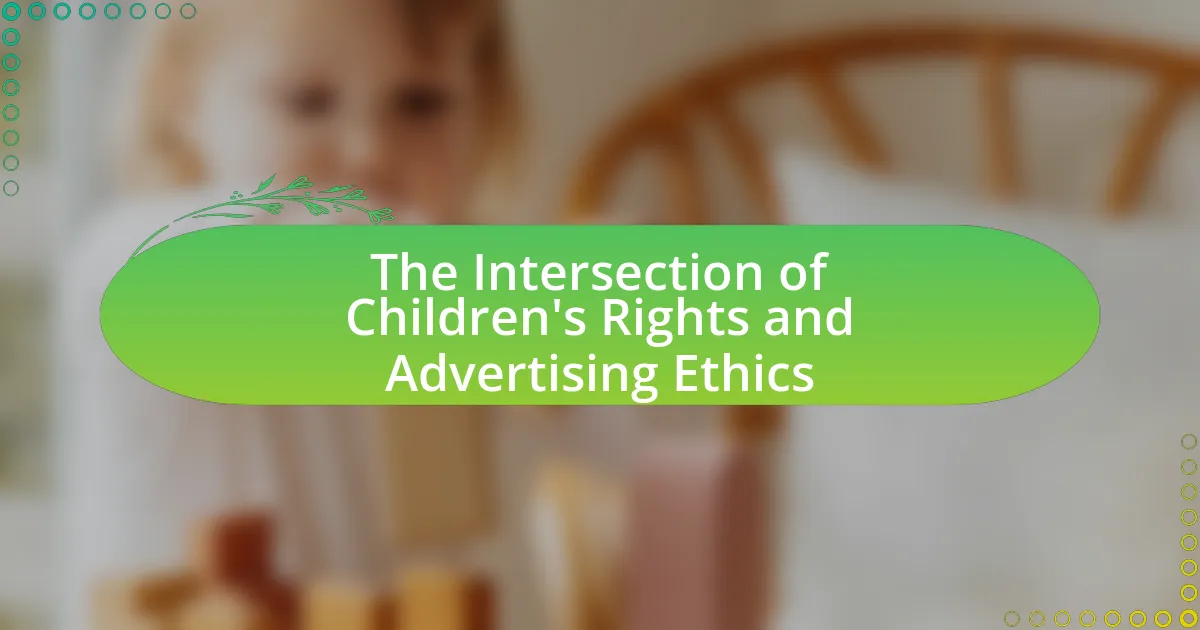Children’s advertising is a specialized marketing practice aimed at promoting products and services to children, characterized by vibrant visuals, catchy jingles, and relatable characters. This article explores the unique aspects of children’s advertising, including its differences from general advertising, the ethical considerations involved, and the regulations that govern it. It highlights the importance of creativity in engaging young audiences while maintaining ethical standards to protect them from manipulation and exploitation. Additionally, the article discusses successful ethical advertising campaigns and best practices for advertisers to ensure responsible marketing to children.
What is Children’s Advertising?
Children’s advertising is a marketing practice specifically aimed at promoting products and services to children. This form of advertising often utilizes colorful visuals, catchy jingles, and relatable characters to capture the attention of young audiences. Research indicates that children are particularly susceptible to advertising messages, with studies showing that they can recognize brands and products as early as age two. The American Psychological Association highlights concerns regarding the impact of such advertising on children’s behavior and consumer habits, emphasizing the need for ethical considerations in how products are marketed to this vulnerable demographic.
How does Children’s Advertising differ from general advertising?
Children’s advertising differs from general advertising primarily in its target audience and the ethical considerations involved. While general advertising aims to persuade a broad demographic, children’s advertising specifically targets children, often using vibrant visuals, catchy jingles, and relatable characters to capture their attention. Additionally, children’s advertising is subject to stricter regulations to protect young audiences from misleading claims and exploitative tactics, as evidenced by guidelines established by organizations such as the Federal Trade Commission, which emphasize the need for honesty and clarity in marketing directed at children.
What are the unique characteristics of Children’s Advertising?
Children’s advertising is characterized by its use of bright colors, animated characters, and simple language to capture the attention of young audiences. These elements are designed to engage children’s imaginations and emotions, making the advertisements more appealing. Additionally, children’s advertising often incorporates themes of fun and play, aligning with children’s interests and developmental stages. Research indicates that children are particularly susceptible to persuasive messaging, which is why advertisers frequently use familiar characters and catchy jingles to create memorable associations with products. This approach is supported by studies showing that children are more likely to remember advertisements that feature engaging visuals and relatable characters.
Why is targeting children a distinct approach in advertising?
Targeting children is a distinct approach in advertising because children are impressionable and often lack the critical thinking skills to evaluate marketing messages. This demographic is particularly susceptible to persuasive techniques, making them a prime audience for brands aiming to establish long-term loyalty. Research indicates that children aged 8 to 12 can recognize and recall advertisements more effectively than adults, highlighting their vulnerability to advertising strategies. Furthermore, the Children’s Advertising Review Unit (CARU) emphasizes the need for ethical standards in marketing to children, as their cognitive development stages affect their understanding of commercial intent. This distinctiveness necessitates a careful balance between creativity and ethical considerations in advertising practices aimed at young audiences.
What are the primary goals of Children’s Advertising?
The primary goals of children’s advertising are to promote products and services specifically designed for children while influencing their purchasing decisions. Advertisers aim to create brand awareness among young audiences, foster brand loyalty, and encourage parental purchases through persuasive messaging. Research indicates that children are highly susceptible to advertising, with studies showing that they can recognize brands as early as age two, which underscores the effectiveness of targeted marketing strategies. Additionally, children’s advertising often seeks to engage children through entertaining content, utilizing characters and narratives that resonate with their interests, thereby enhancing the likelihood of product recall and preference.
How do advertisers engage children effectively?
Advertisers engage children effectively by utilizing vibrant visuals, interactive content, and relatable characters. These strategies capture children’s attention and foster emotional connections, making the advertisements more memorable. For instance, research indicates that advertisements featuring animated characters can increase children’s recall by up to 50%, as they resonate with children’s imaginative play. Additionally, incorporating games or interactive elements encourages active participation, further enhancing engagement. This approach aligns with findings from the American Psychological Association, which highlight that children are more likely to respond positively to advertisements that incorporate fun and playfulness.
What role does creativity play in achieving these goals?
Creativity plays a crucial role in achieving the goals of children’s advertising by enabling the development of engaging and memorable content that resonates with young audiences. This engagement is essential for capturing children’s attention and fostering brand loyalty, as studies indicate that creative advertisements are more likely to be remembered by children compared to standard ads. For instance, research published in the Journal of Advertising Research shows that imaginative storytelling and colorful visuals significantly enhance children’s recall of advertisements. Thus, creativity not only attracts attention but also aids in effectively communicating messages in a way that aligns with ethical standards, ensuring that the content is both appealing and appropriate for children.
What ethical considerations are involved in Children’s Advertising?
Ethical considerations in children’s advertising primarily involve the protection of vulnerable audiences from manipulation and exploitation. Advertisers must ensure that their messages do not mislead children about the nature or benefits of products, as children may lack the cognitive ability to critically evaluate advertising claims. For instance, the American Psychological Association highlights that children under eight are particularly susceptible to persuasive techniques, necessitating stricter guidelines to prevent deceptive practices. Additionally, there are concerns regarding the promotion of unhealthy food choices, which can contribute to childhood obesity; research indicates that exposure to junk food advertising is linked to poor dietary habits among children. Therefore, ethical advertising practices must prioritize transparency, honesty, and the well-being of children to foster responsible consumption.
Why is ethics important in advertising to children?
Ethics is crucial in advertising to children because it protects vulnerable audiences from manipulation and harmful content. Children are impressionable and may not fully understand the persuasive intent behind advertisements, making them susceptible to misleading claims. Ethical advertising ensures that marketing practices promote honesty, transparency, and respect for children’s developmental stages. For instance, the American Psychological Association emphasizes that children under eight cannot distinguish between commercials and programming, highlighting the need for ethical standards to prevent exploitation. By adhering to ethical guidelines, advertisers can foster a responsible marketing environment that prioritizes children’s well-being and supports healthy consumer habits.
What are the potential risks of unethical advertising practices?
Unethical advertising practices pose significant risks, including consumer deception, brand reputation damage, and legal repercussions. Consumer deception can lead to misguided purchasing decisions, particularly among vulnerable populations like children, who may not fully understand the intent behind advertisements. This can result in a loss of trust in brands and the advertising industry as a whole. Furthermore, brands engaging in unethical practices may face backlash from consumers and advocacy groups, leading to negative publicity and diminished brand loyalty. Legal repercussions can arise from violations of advertising standards and regulations, resulting in fines and sanctions. For instance, the Federal Trade Commission has enforced penalties against companies for misleading advertisements, highlighting the legal risks associated with unethical advertising.
How can ethical guidelines protect children from exploitation?
Ethical guidelines protect children from exploitation by establishing standards that prioritize their welfare and rights in advertising practices. These guidelines restrict misleading content, ensuring that advertisements do not manipulate children’s vulnerabilities or promote harmful behaviors. For instance, the American Psychological Association emphasizes that ethical advertising should avoid exploiting children’s naivety, thereby safeguarding their mental and emotional well-being. Furthermore, regulations like the Children’s Online Privacy Protection Act (COPPA) enforce strict rules on data collection and marketing directed at children, reducing the risk of exploitation in digital spaces.
What regulations exist to govern Children’s Advertising?
Regulations governing children’s advertising include the Children’s Online Privacy Protection Act (COPPA) in the United States, which restricts the collection of personal information from children under 13 without parental consent. Additionally, the Federal Trade Commission (FTC) enforces guidelines that prohibit deceptive advertising practices targeting children. In the European Union, the Audiovisual Media Services Directive (AVMSD) sets strict rules on advertising to children, including limitations on the types of products that can be marketed and the timing of such advertisements. These regulations aim to protect children from exploitation and ensure that advertising is appropriate for their age and understanding.
How do different countries approach advertising regulations for children?
Different countries implement varying approaches to advertising regulations for children, reflecting cultural values and societal concerns. For instance, Sweden and Norway have stringent laws that prohibit all forms of advertising directed at children under 12, aiming to protect young audiences from commercial exploitation. In contrast, the United States employs a more lenient framework, where the Federal Trade Commission (FTC) regulates advertising practices but allows for significant advertising directed at children, provided it adheres to guidelines on truthfulness and fairness. The European Union has established directives that encourage member states to adopt measures protecting children from misleading advertising, yet the enforcement and specifics can differ widely among countries. These regulatory differences highlight the balance each nation seeks between fostering creativity in advertising and ensuring ethical standards to protect children.
What impact do these regulations have on advertising strategies?
Regulations on children’s advertising significantly restrict the content and methods used in marketing to young audiences. These regulations often mandate truthfulness, limit the use of persuasive techniques, and prohibit misleading claims, which forces advertisers to adopt more ethical and transparent strategies. For instance, the Children’s Online Privacy Protection Act (COPPA) in the United States requires parental consent for data collection from children under 13, compelling advertisers to rethink their data-driven approaches. Consequently, advertisers must focus on creating age-appropriate, educational, and entertaining content that complies with these legal standards, ultimately reshaping their overall advertising strategies to prioritize ethical considerations over aggressive marketing tactics.
How can creativity be balanced with ethics in Children’s Advertising?
Creativity in children’s advertising can be balanced with ethics by adhering to guidelines that prioritize the well-being of children while still engaging them effectively. Regulatory frameworks, such as the Children’s Online Privacy Protection Act (COPPA) in the United States, set standards for how advertisers can interact with children, ensuring that advertisements do not exploit their naivety or lack of experience. Additionally, employing age-appropriate messaging and avoiding manipulative tactics, such as fear or peer pressure, helps maintain ethical standards. Research indicates that ethical advertising practices not only protect children but also enhance brand reputation and consumer trust, demonstrating that creativity can coexist with ethical responsibility in children’s advertising.
What strategies can advertisers use to maintain ethical standards while being creative?
Advertisers can maintain ethical standards while being creative by implementing transparency, ensuring age-appropriate content, and adhering to regulatory guidelines. Transparency involves clearly disclosing the intent and nature of advertisements, which builds trust with both children and parents. Age-appropriate content ensures that messages resonate with the developmental stages of children, avoiding manipulation or exploitation. Adhering to regulatory guidelines, such as those set by the Federal Trade Commission, helps ensure that advertisements do not mislead or harm young audiences. These strategies collectively foster a responsible advertising environment that prioritizes the well-being of children while allowing for creative expression.
How can storytelling be used ethically in Children’s Advertising?
Storytelling can be used ethically in children’s advertising by ensuring that narratives promote positive values and do not manipulate or exploit children’s vulnerabilities. Ethical storytelling involves creating relatable characters and scenarios that encourage critical thinking, empathy, and social responsibility. For instance, advertisements that feature children engaging in teamwork or helping others can foster a sense of community and cooperation. Research indicates that children are more likely to internalize messages that align with their values and experiences, making ethical storytelling a powerful tool for positive influence. By adhering to guidelines set by organizations like the American Psychological Association, advertisers can ensure that their storytelling respects children’s developmental stages and cognitive abilities, thereby promoting ethical practices in children’s advertising.
What role does transparency play in ethical advertising to children?
Transparency is crucial in ethical advertising to children as it fosters trust and ensures that young audiences can distinguish between entertainment and marketing. By clearly disclosing the intent behind advertisements, companies help children understand that they are being marketed to, which is essential for informed decision-making. Research indicates that transparent advertising practices can reduce the likelihood of misleading children, as evidenced by guidelines from organizations like the American Psychological Association, which emphasize the importance of clarity in messaging aimed at younger audiences. This approach not only protects children from potential exploitation but also promotes responsible advertising practices within the industry.
What are some examples of successful ethical Children’s Advertising campaigns?
Some examples of successful ethical children’s advertising campaigns include the “Share a Coke” campaign by Coca-Cola, which encouraged children to share drinks with friends and family, promoting social interaction and sharing. Another example is the “Like a Girl” campaign by Always, which aimed to empower young girls by redefining the phrase “like a girl” to mean strength and confidence, positively impacting self-esteem. Additionally, the LEGO “Build the Future” campaign focused on creativity and imagination, encouraging children to envision their future through play. These campaigns are recognized for their positive messaging and alignment with ethical advertising standards, promoting values that resonate with children and their development.
What lessons can be learned from these campaigns?
Lessons learned from children’s advertising campaigns include the importance of ethical considerations in marketing to young audiences. Campaigns that prioritize transparency and honesty foster trust and positive brand perception among children and parents. For instance, research indicates that advertisements featuring relatable characters and educational content can enhance engagement while promoting ethical standards. Additionally, campaigns that comply with regulations, such as the Children’s Online Privacy Protection Act (COPPA), demonstrate a commitment to protecting children’s privacy and well-being. These lessons underscore the necessity of balancing creativity with responsibility in advertising directed at children.
How do these examples demonstrate a balance between creativity and ethics?
These examples demonstrate a balance between creativity and ethics by showcasing innovative advertising strategies that engage children while adhering to ethical standards. For instance, campaigns that utilize storytelling and relatable characters captivate young audiences without exploiting their vulnerabilities. Ethical guidelines, such as those set by the American Psychological Association, emphasize the importance of not misleading children or promoting unhealthy behaviors. By integrating fun and educational content, these advertisements foster creativity while ensuring that the messages conveyed are responsible and age-appropriate. This dual focus on imaginative engagement and ethical responsibility exemplifies how effective children’s advertising can thrive within a framework that prioritizes both creativity and ethical considerations.
What best practices should advertisers follow in Children’s Advertising?
Advertisers should prioritize transparency, age-appropriate messaging, and ethical content when engaging in children’s advertising. Transparency involves clearly disclosing the intent of advertisements, ensuring that children understand they are being marketed to. Age-appropriate messaging requires that the content is suitable for the developmental stage of the target audience, avoiding complex themes that children may not comprehend. Ethical content mandates that advertisements do not exploit children’s vulnerabilities, such as their inability to critically evaluate marketing messages. Research from the American Psychological Association indicates that children are particularly susceptible to persuasive advertising techniques, underscoring the need for responsible practices in this domain.
How can advertisers ensure they are being responsible and ethical?
Advertisers can ensure they are being responsible and ethical by adhering to established guidelines and regulations that protect vulnerable audiences, particularly children. This includes following the American Psychological Association’s recommendations, which emphasize the importance of not exploiting children’s inexperience and ensuring that advertisements do not mislead or manipulate young audiences. Additionally, advertisers should engage in transparent practices, such as clearly labeling advertisements and avoiding deceptive tactics that could harm children’s understanding of the content. By implementing these strategies, advertisers can promote ethical standards while fostering a safe advertising environment for children.
What tools and resources are available for ethical advertising practices?
Tools and resources available for ethical advertising practices include guidelines from organizations such as the American Advertising Federation (AAF) and the Children’s Advertising Review Unit (CARU). These organizations provide frameworks that promote responsible advertising, particularly aimed at children, ensuring that advertisements are truthful, not misleading, and appropriate for the target audience. Additionally, the Federal Trade Commission (FTC) offers resources and regulations that govern advertising practices, emphasizing transparency and fairness. Research indicates that adherence to these guidelines can enhance brand reputation and consumer trust, as ethical advertising practices are increasingly valued by the public.






